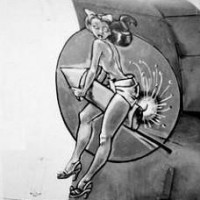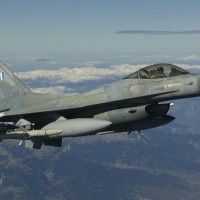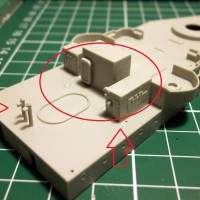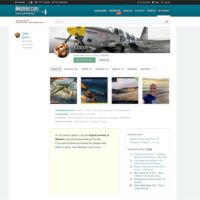iModeler Review: Arma Hobby 1/48 P-39Q Airacobra
Arma Hobby has just announced a 1/48 scale model kit of the Bell P-39Q Airacobra. This entirely new product is a welcome addition to the company's emerging quarter-scale range.
I was privileged to examine the kit on the day of its public reveal and was kindly granted access to the test shots and a prototype model for the first comprehensive review.
Arma Hobby 1/48 P-39Q Airacobra, cat. no 40010
- Injection-moulded kit
- Self-adhesive masks for canopy
- Nose weights
- Decal sheet with 3 marking options
- Retail price €38.18
The sprues
The kit includes three sprues molded in grey plastic plus a clear sprue. The breakdown of parts reminds of the preceding 1/72 Airacobra kit from the same company, but the detail has been enhanced to take full advantage of the larger scale.
Although listed as the P-39Q version, the kit provides all the parts necessary for other production variants, from P-39D/P-400 to P-39N and Q. There's a choice of three different propellers, three nose armament variants, two different nose wheels, bombs, fuel tanks, and an underwing cannon gondolas.
The stability of the model is ensured by solid steel balls that fit into appropriate slots in the kit's structure and provide weight to prevent the finished model from tail-sitting.
Surface detail
Upon presenting the test sprues, Arma Hobby explained that they are not 100% representative of the final product. While the recessed details (such as panel lines and bolts) are fully reproduced, some minute raised details still remains to be machined into the forms. Please keep this in mind when assessing the kit from the following pictures.
The fuselage detail includes fine recessed panel lines and recessed dots where screws or bolts were used on real aircraft. There are no rivet lines. The real P-39 was flush-riveted, making the rivets barely noticeable even on the full-size aircraft. This seems to be the reason why Arma Hobby decided to leave out rivet detail.
The same design choice is visible on the wings. The "rivets" visible between the two wing spars are lines of screws used to hold the fuel tank.
The key word here is "balance." My first impression was that this kit appears more restrained in terms of surface detail than the preceding 1/48 Hurricane or P.11c from the same company. While minute surface detail is in vogue, the choice of whether or not to include full rivet detail in a 1/48 scale kit is not obvious—do you want the model to be more interesting to look at, or would you rather it resemble the real aircraft more closely? Arma Hobby seems to strike their own balance between the two, and I support the logic of their approach.
Another point to note is the quality of the test sprues. They are low-pressure test shots made in a different type of plastic than production kits, which combined results in notable amounts of flash and distortion on some parts. These are normal test-shot deficiencies that should not be present in the final product. Knowing Arma Hobby's commitment to excellence, I expect the final moldings to look and fit perfectly.
The test model
Color & marking options
The kit provides markings and color guide for three different aircraft:
- P-39Q-1 Airacobra, 46th Fighter Squadron, 15th Fighter Group, Makin, Gilbert Islands, late 1943.
- P-39Q-10 Airacobra, 363rd Fighter Squadron, 357th Fighter Group, pilot Lt. Clarence “BUD” Anderson, Oroville, California, October 1943.
- P-39Q-15 Airacobra, 68th GIAP, 5th GIAD, winter 1944-45.
The decals, printed by Cartograf, look excellent.
Reviewer's opinion
Up-scaling a successful 1/72 kit seems like a logical choice for Arma Hobby. But do we need another P-39 in 1/48 scale? My answer is hmm... a sightly reluctant yes.
The nearest competitor to this kit is Eduard's P-39, first released in 2000. Although overall a good kit, it is not up to current standards, with issues such as poor canopy fit and overly thick trailing edges. Given these flaws, I'd prefer Arma's offering.
Hasegawa's 1/48 P-39 from 2006 is newer and better than Eduard's, even though it doesn't include nose weights. It's an excellent and very buildable kit, one of Hasegawa's best. It's wheel wells are molded integrally with the lower wing, and the rudder/elevator are not separate, but otherwise, it is hard to fault. But the Hasegawa kit hasn't been re-released since 2013, so its current availability is scarce.
Back in the 1990s, a new kit of a popular subject could mean a quantum leap in quality over the older competition. Today's prerequisites are different. A new kit of a popular subject is often competing with an already excellent legacy offering. This seems to be the case with Arma Hobby's 1/48 P-39 line.
With meticulously researched subject, a wealth of detail, excellent build experience, Cartograph decals and masks, the Arma Hobby kit aspires to be a "complete package" of choice for a P-39 enthusiast. It also comes at a lower price than the acclaimed Hurricane from the same company, which will surely be appreciated by buyers. I do feel that its long-term success will depend on the sum of many subtle qualities rather than a single "wow factor". I wish Arma success in this endeavor.
PS: A few days after writing this review I had the opportunity to once again examine the Hasegawa P-39 kit to see how it compares with Arma's. Interestingly, the quality of surface detail remains rather equivalent between the two kits. The Arma Hobby kit has a few dimples and inspection hatches at the lower wing center that are missing on the Hasegawa kit, but that's about it. As for other "accuracy" differences, it is hard to tell. Both kits feature weighted tires, which is great. Neither provides a good solution for seat belts. Both allow to build all major versions of the Cobra, but the Arma kit contains all the necessary parts in one box, while Hasegawa features various extra sprues in the different boxings. The fabric surfaces look better in the Arma kit. Also, Cartograf decals are a clear plus.
Looking for the differences in plastic, the Hasegawa kit has shallower, integrally molded wheel wells, and the tail control surfaces are not poseable. It also has ejector pin marks in a few places that may require sanding. And it leaves adding nose weight to the builder.
So yes, the Arma Hoby kit offers a refinement of the subject, but the margins are narrow indeed!
This is a highly recommended kit. If you haven't yet built an Airacobra in this scale, it seems to be the one to buy!











































@editor
Martin, thank you for writing this review and sharing your thoughts and opinions about this kit with the forum. I share many of what you wrote here.
After having built their Hurricane I was a bit eager to see what subject would Arma release next in 1/48 scale, and I’m sure I was not the only one not surprised they chose the Airacobra for that matter…it made sense business sense that is.
The quality of the Hurricane surface detail is a hard act to beat, and from what I’ve read in their FB page, not only the P-39 surfaces are rivet flushed but their goal was also delivering a product that could be less expensive for the buyer than the Hurricane was and still given them the target sales profit…so yes I guess like you say it’s a balanced kit, and will probably beat both market contenders in many regards.
The only thing I feel is a let down is that this time Arma only offer PDF files for the customer to 3D print a whole lot of parts at home, parts that they could also sell in those bundle deals, not everyone owns a 3D printer. No doubt other companies will happily sell these resin “improved” parts sooner or later.
Again thank you and sorry for the long reply 🙂
Thanks, @holzhamer
The print-at-home 3D accessories are something of an experiment, I guess. The company representative told me that they were quite popular, so this may well become trend in the future? Time will tell
Shorter reply: gimme, gimme, gimme!
🙂
Thanks for this review, Martin!
🙂
A great review of what seems to be a great kit, Martin @editor
Thanks for sharing.
Yes there's no doubt that this seems like a great kit.
I'll be getting one for review at Modeling Madness, but I think that will be it. I managed to snag several Hasegawa P-39s a few months ago at my LHS's continuing "Estate Sale." I don't see that much superior. For those interested, Eduard recently re-released their P-39, with a full cockpit interior p-e set - instrument panels etc., which is for sale separately.
I can see why they wouldn't have stepped into the P-40 line, since Eduard's complete series is due to appear this fall.
I have since had the opportunity to scrutinize the Hasegawa P-39 up-close and yes, I have added the Post Scriptum. There can only be one "best" kit per scale and Arma seems to take the lead.
Editor (@editor)
Thank you for taking the time to post this article. It does indeed look like a very nice kit, and one that I will likely end up purchasing at some point.
Thanks Louis.
What Louis @lgardner said!
Thank you Martin @editor !
👍
Thanks for the review! Can’t wait to get mine!
One note: there is no “ph” in Italian. The decal printer is Cartograf.
Thank for point out the error, @jrheilig! Corrected.